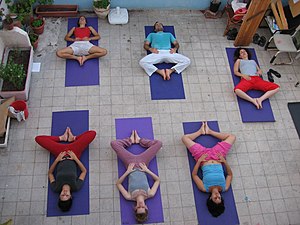 Image via WikipediaHatha Yoga
Image via WikipediaHatha YogaMost yoga styles are Hatha based. In fact there are more than 90 different types of Hatha yoga. Hatha yoga is based on poses or asanas, cleansing techniques and breathing. If you’re looking at a yoga class or practice chances are it is a form of Hatha yoga. Ha and tha mean sun and moon. It’s a forceful type of yoga that can be physically demanding. However, when most people talk about yoga they’re referring to Hatha yoga. It’s the most popular type of yoga.
Ashtanga Yoga
Ashtanga is a type of Hatha yoga. It is physically demanding. You’ll move quickly through series of postures. This type of yoga is designed to build strength, flexibility, and endurance. If you’re a beginner, only take an Ashtanga yoga class if they offer beginner instruction classes. Consider starting with a basic Hatha yoga class to learn the postures and breathing first.
Kundalini Yoga
Kundalini yoga is more focused on the breath and release of energy than other forms of yoga. In a Kundalini class you’ll likely see the same classic poses you’d find in a Hatha yoga class. However, you’ll spend more time focusing on breathing and coordinating your breathing to your movements. You’ll also likely spend a bit more time on meditation than in a standard Hatha yoga class.
 Cover via AmazonPower Yoga or Power Vinyasa
Cover via AmazonPower Yoga or Power VinyasaPower yoga is often also Hot Yoga meaning it takes place in a heated room. Most rooms are gnerally around a 100 degrees. The goal is to eliminate toxins from your body through sweat. Power yoga is more active and physically demanding than other yoga styles. Generally the goal is to improve strength and flexibility however you’ll move through the poses quite quickly.
Take a beginners course if you’re not familiar with standard yoga poses. In a power yoga class you certainly won’t have time to figure out what the instructor is doing before they move onto the next pose. It is important to be somewhat knowledgeable so you get the most out of the class.
Also, if the course is taught in a hot room make sure it’s safe for you. If you have high blood pressure or other conditions spending ninety minutes in a 100 degree room while exercising may not be good for your health.
Be sure to check back on Thursday for Part II, where we will cover several more yoga styles! Or if you are ready to get started with some fun yoga workouts, check these out below.
Fun Yoga For Beginners (and Beyond):

No comments:
Post a Comment